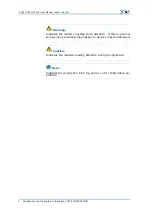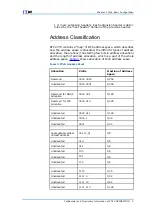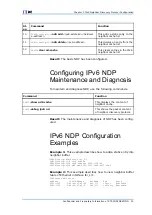
ZXR10 T600/T1200 User Manual (IPv6 Volume)
In the environment mixed with IPv4 and IPv6, there may be a third
way. The least significant 32-bit in an IPv6 address can be used
to express an IPv4 address in a mixed way: X:X:X:X:X:X:d.d.d.d,
among which X represents a 16-bit and d indicates a 8-bit decimal
integer.
For example, the address 0:0:0:0:0:0:10.0.0.1 is a legal IPv4 ad-
dress. Therefore, this address is expressed as: 10.0.0.1 by com-
bining the two possible expressions.
An IPv6 address consists of two parts: subnet prefix and interface
identifier. An IP node address is expected to be expressed in a way
similar to that of a CIDR address, as an address carrying an extra
value, indicating how many bits of the address is the mask.
An IPv6 node address indicates the length of a prefix by separating
the length from the IPv6 address with a slash.
For example, in the address of
1030:0:0:0:C9B4:FF12:48AA:1A2B/60, the length of the prefix
for routing is 60-bits
IPv6 Host Address
An IPv6 host has many IPv6 addresses even if it has only one single
interface. An IPv6 host can have the following unicast addresses
simultaneously.
�
The link-local address of each interface
�
The unicast address of each interface, which can be a site-local
address or one or more aggregable global addresses
�
Loopback address (::1) of a loopback interface
In addition, each host must always keep listening to the data from
the following multicast addresses.
�
Multicast addresses (FF01::1) of all the nodes within the node-
local range
�
Multicast addresses (FF02::1) of all the nodes within the link-
local range
�
Multicast address of the solicited-node (if the solicited-node
group is added to an interface of the host)
�
Multicast address of a multicast group (if any multicast group
is added to an interface of the host)
IPv6 Router
Address
The following unicast addresses can be allocated to an IPv6 router:
�
Link-local address of each interface
�
Unicast address of each interface, which can be a site-local
address or one or more aggregable global addresses
�
Subnet-router anycast address
�
Other anycast addresses (optional)
�
Loopback address (::1) of a loopback interface
Similarly, apart from these addresses, a router must always keep
listening to the data flow from the following multicast addresses.
�
Multicast addresses (FF01::1) of all the nodes within the node-
local range
�
Multicast addresses (FF02::1) of all the nodes within the link-
local range
14
Confidential and Proprietary Information of ZTE CORPORATION
Содержание ZXR10 T1200
Страница 5: ...Figures 71 Tables 73 List of Glossary 75 ...
Страница 6: ......
















































